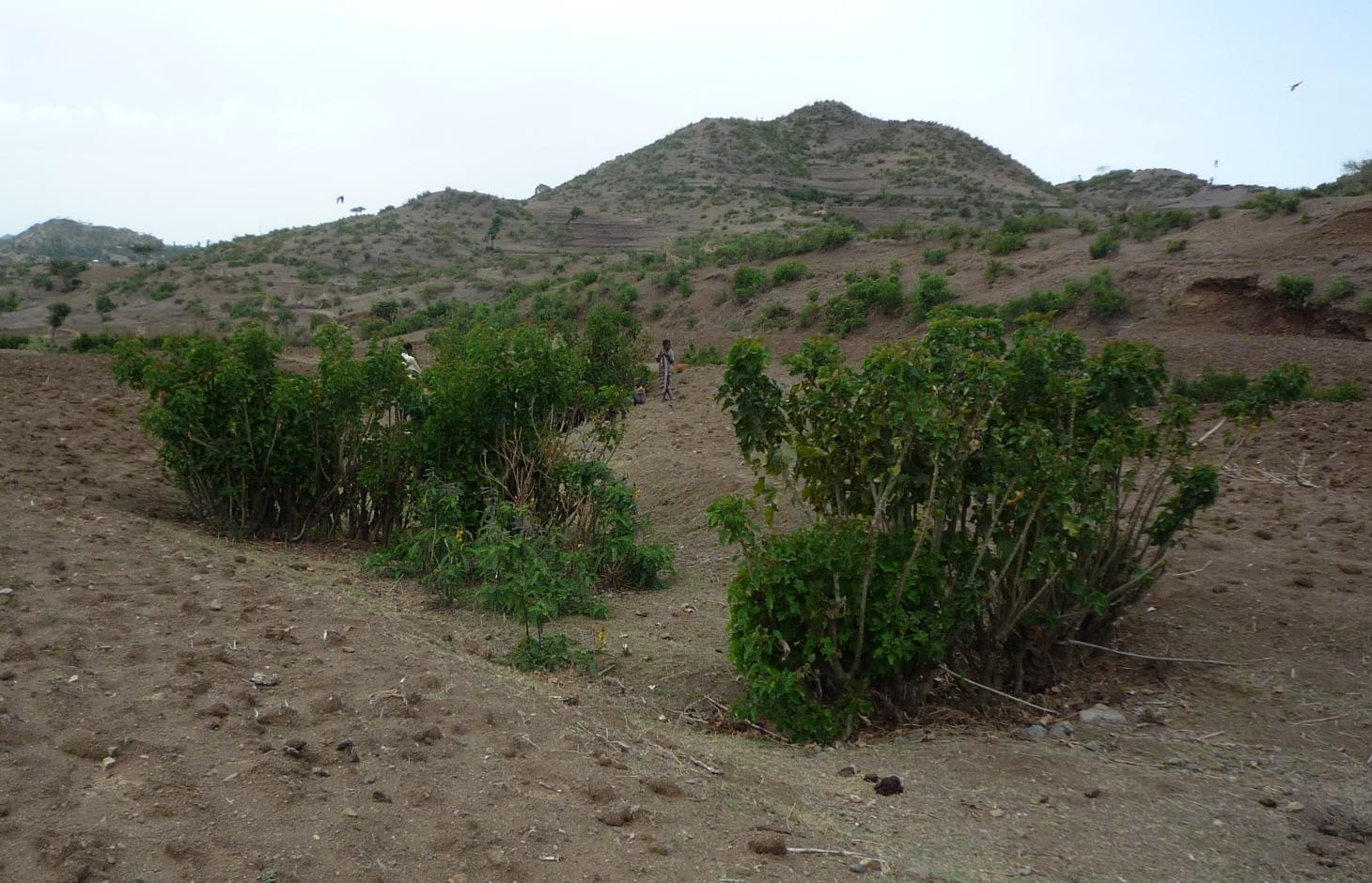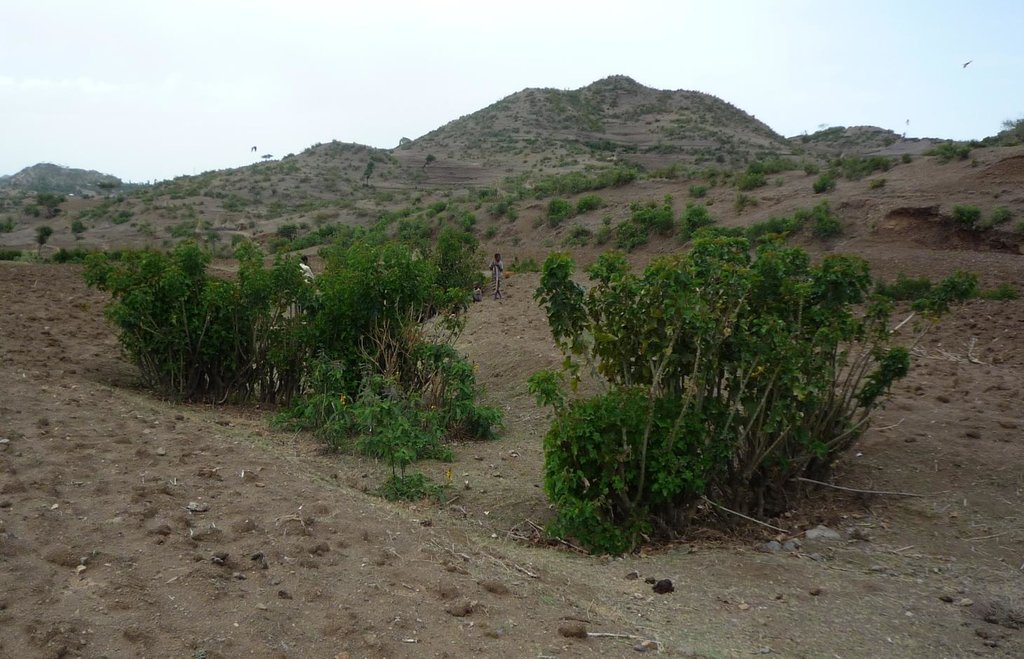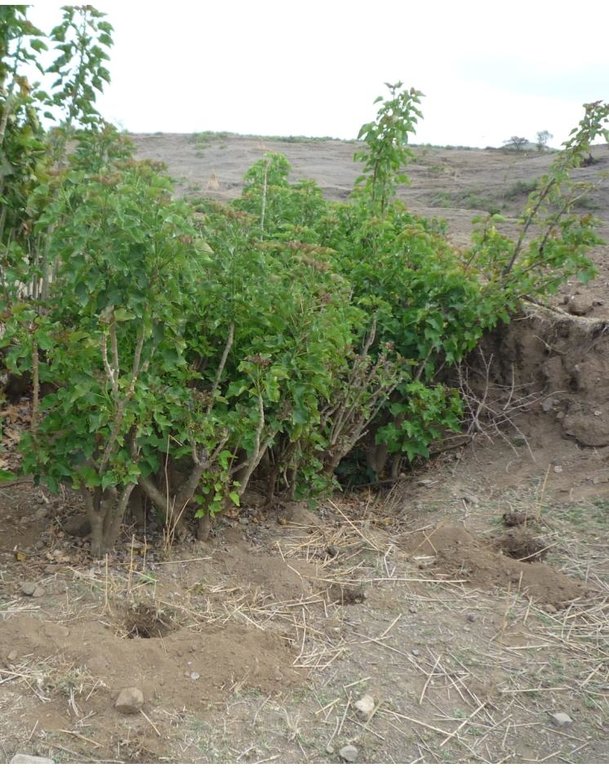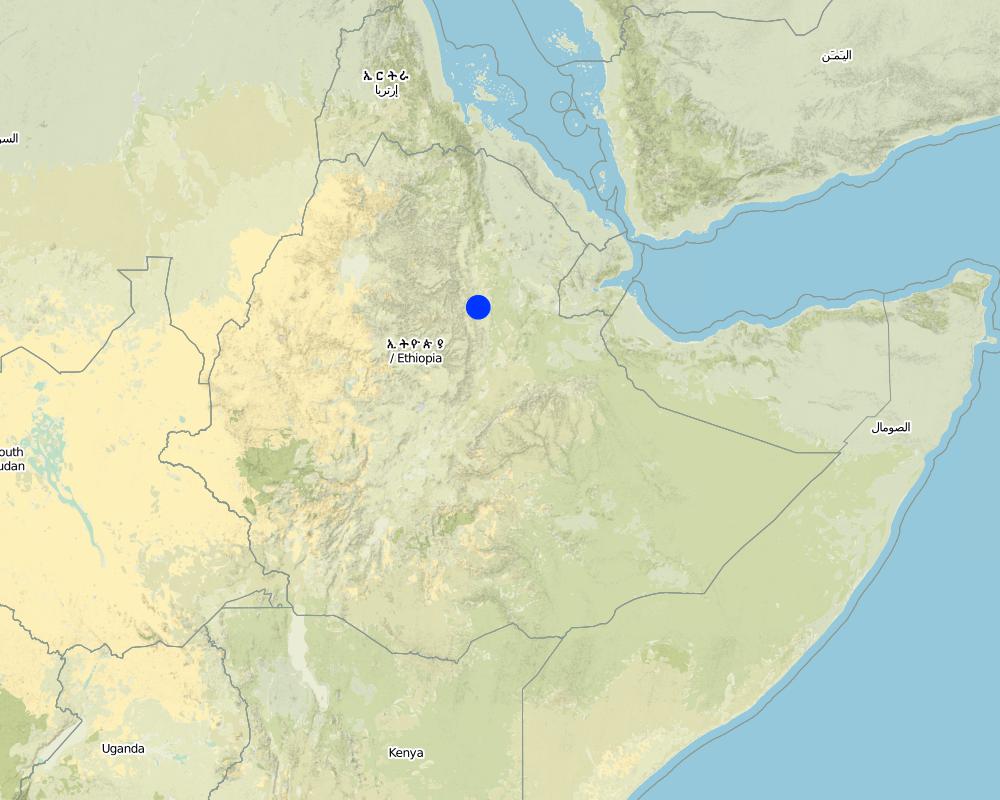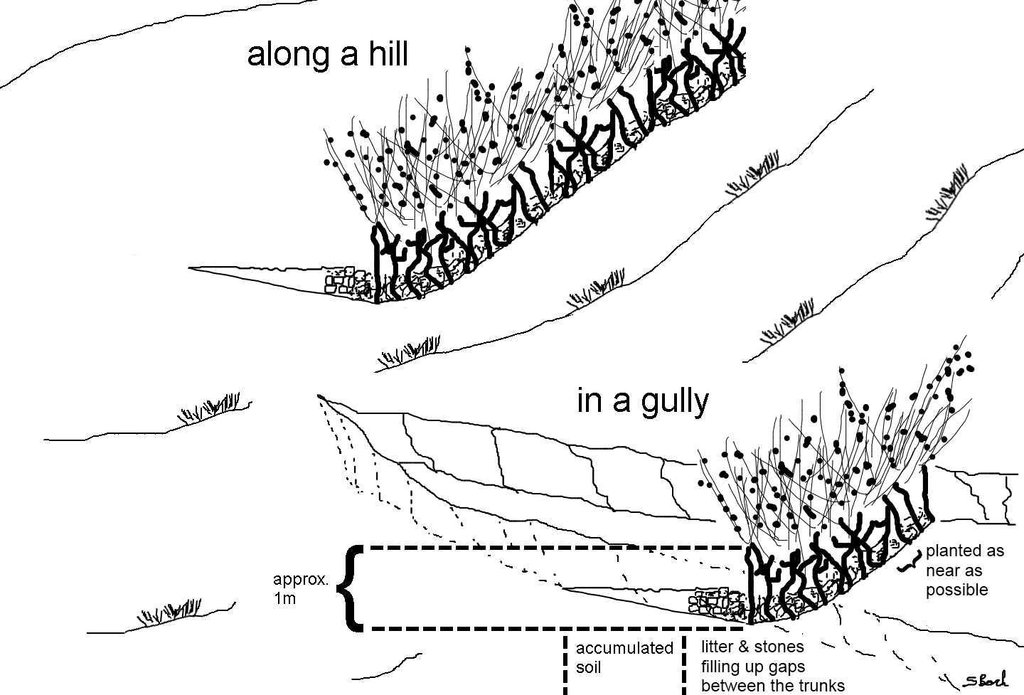Jatropha curcas hedge [أثيوبيا]
- تاريخ الإنشاء:
- تحديث:
- جامع المعلومات: Simon Bach
- المحرر: –
- المراجعون: Fabian Ottiger, Alexandra Gavilano
Agulo Keter
technologies_1524 - أثيوبيا
عرض الأقسام
توسيع الكل طي الكل1. معلومات عامة
1.2 تفاصيل الاتصال بالأشخاص الرئيسيين لمصدر المعلومات والمؤسسات المشاركة في تقييم وتوثيق التقنية
متخصص في الإدارة المستدامة للأراضي:
Ayele Habtamu
Haramaya University
أثيوبيا
اسم المؤسسة (المؤسسات) التي سهلت توثيق/تقييم التقنية (إذا كان ذلك على صلة)
Haramaya University (HU) - أثيوبيا1.3 الشروط المتعلقة باستخدام البيانات الموثقة من خلال WOCAT
يوافق جامع المعلومات والشخص (لاشخاص) الرئيسي لمصدر المعلومات على الشروط المتعلقة باستخدام البيانات الموثقة من خلال WOCAT:
نعم
2. وصف تقنيةالإدارة المستدامي للأراضي
2.1 وصف مختصر للتقنية
تعريف التقنية:
Gully rehabilitation and hill stabilization with Jatropha hedges.
2.2 وصف تفصيلي للتقنية
الوصف:
In the area around Bati in Ethiopia, Jatropha is used to stabilize hills ore to rehabilitate gullies. The technology was introduced during the last decade by local farmers on their plots. The advantage of Jatropha against other shrubs is that it is poisonous and therefore not browsed by animals. Additionally the seeds can be collected by household members and sold on the local market. The seed's oil can be used as a lamp oil or even for the production of bio-fuel.
Purpose of the Technology: Besides hedges and living fences, Jatropha is used for combating sheet or gully erosion. To stop erosion processes the Jatropha cuttings are planted across a gully or along hill sides to stabilize them in the same manner as check dams or terraces do. The plant is chosen because of its very tolerant character, rather high accessibility in the area and because it is easy to propagate by cuttings. Often Jatropha is used in combination with traditional stone check dams or terraces aiming for an increased stability of the technology itself. For that purpose Jatropha is planted in front of the stone walls or also on top of them.
Establishment / maintenance activities and inputs: In earlier times Jatropha was planted by seeds but nowadays, since there are a lot of plants in the area, propagation by cuttings is the more prominent form. Since the plants are pruned every year anyway, the cuttings are accessible almost in any case for free. At markets further away, the cuttings cost around one cent per piece. In order to rehabilitate a gully Jatropha cuttings are planted as near as possible in the selected area in a row across the gully. After rooting, the spaces between the plants are filled up with litter, shrubs or stones. In order to have a thick stem and avoid competition with crops, the plants are pruned every year. The thick main stems reach a height of approximately one meter which delineates the maximum height of possible soil collection. If the area behind the filled up gaps and the cuttings has silted up, the height is increased by adding new litter in the higher up gaps. In off farming season, the Jatropha seeds are collected and sold on the market to create additional income.
Natural / human environment: The case study site, Bati, lays in an semiarid climatic zone on 1600 m a.s.l. Rainfalls are erratic and the rain sum per year is between 500-1000 mm. The landscape is very hilly with rather steep slopes. The area has a high population density and growth. The agricultural sector is very dominant and lead by a lot of small scale farming with a lot of livestock and small plots of cropland.
2.3 صور التقنية
2.5 البلد/المنطقة/المواقع التي تم تنفيذ التقنية فيها والتي يغطيها هذا التقييم
البلد:
أثيوبيا
المنطقة/الولاية/المحافظة:
Ethiopia / Amhara Region
مزيد من التفاصيل حول الموقع:
Bati
التعليقات:
Total area covered by the SLM Technology is 0.7 km2.
Size of the case study watershed.
Map
×2.6 تاريخ التنفيذ
في حالة عدم معرفة السنة بالتحديد، يرجى الإشارة إلى التاريخ التقريبي:
- منذ 10-50 سنة
2.7 إدخال التقنية
حدد كيف تم إدخال التقنية:
- من خلال ابتكار مستخدمي الأراضي
التعليقات (نوع المشروع، الخ):
Farmers are using Jatropha curcas since approximately 30 years in the research area in Bati mostly for fencing. Innovative farmers started using the plant for stabilizing existing physical structures (stone walls, terraces, gully check dams) or using it as a complete substitute for these physical structures.
3. تصنيف تقنية الإدارة المستدامي للأراضي
3.1 الغرض الرئيسي ( الأغراض الرئيسية) للتقنية
- الحد من تدهور الأراضي ومنعه وعكسه
- خلق أثر اقتصادي مفيد
3.2 نوع (أنواع) استخدام الأراضي الحالية حيث يتم تطبيق التقنية
استخدامات الأراضي مختلطة ضمن نفس وحدة الأرض:
نعم
حدد استخدام الأراضي المختلطة (المحاصيل / الرعي / الأشجار):
- الرعي الحرجي

الأراضي الزراعية
- زراعة سنوية
- زراعة الأشجار والشجيرات
الزراعة السنوية - حدد المحاصيل:
- الحبوب - الذرة الرفيعة
- corn
- jatropha curcas
عدد مواسم الزراعة في السنة:
- 1
حدد:
Longest growing period in days: 90 Longest growing period from month to month: June until September

أراضي الرعي
نوع الحيوان:
- الجمال
- ماشية - الألبان
- الماعز
- الدواجن
- الأغنام
التعليقات:
Livestock density (if relevant):
> 100 LU /km2
Major land use problems (compiler’s opinion): Deforestation, overgrazing, cultivation of erosion-sensitive areas or steep slopes.
Major land use problems (land users’ perception): Too much soil loss and land degradation, no vegetation cover and poor soil moisture.
Grazingland comments: Livestock is not fenced in. Children herd the animals and watch out that they do not browse through crop fields. In off-farming season crop residues are collected from the field and stored next to the field. Animals are allowed to eat the still remaining residues on the field. After that, the animals are fed by the collected crop residues.
Livestock is grazing on crop residues
3.4 إمدادات المياه
إمدادات المياه للأرض التي يتم تنفيذ التقنية عليها:
- بعلية
التعليقات:
Water supply: Also mixed rainfed - irrigated
3.5 مجموعةالإدارة المستدامة للأراضي التي تنتمي إليها هذه التقنية
- التدابير المتقاطعة للمنحدرات
3.6 التدابير التقنية في مجال إلادارة المستدامة للأراضي

التدابير النباتية
- V1: غطاء من الأشجار والشجيرات

التدابير البنيوية
- S1: المصاطب المتدرجة
- S6: الجدران والحواجز وسياجات القش، والسياجات
التعليقات:
Main measures: vegetative measures, structural measures
Type of vegetative measures: aligned: -contour
3.7 الأنواع الرئيسية من تدهور الأراضي التي تناولتها التقنية

تآكل التربة بالمياه
- الوزن(Wt): فقدان التربة السطحية/تآكل السطح
- (Wg):الانجراف الخلجاني/ الخلجان
التعليقات:
Main type of degradation addressed: Wg: gully erosion / gullying
Secondary types of degradation addressed: Wt: loss of topsoil / surface erosion
Main causes of degradation: deforestation / removal of natural vegetation (incl. forest fires) (Deforestation for the past 30 years.), over-exploitation of vegetation for domestic use (Wood collection for cooking and construction.), overgrazing (60% of the watershed area are cultivated - big grazing pressure on remaining land), other human induced causes (specify) (Cultivation of very steep slopes.), change of seasonal rainfall (Erratic rainfall.), Heavy / extreme rainfall (intensity/amounts) (If there is rain, it is intensive.), population pressure (High population pressure.), poverty / wealth (Poor facilities.)
Secondary causes of degradation: soil management (Poor soil management practices and lack of awareness.), crop management (annual, perennial, tree/shrub) (Annual cropping.), droughts (The research area is considered rather dry.), land tenure (If the land is rented, it is poorly managed.), inputs and infrastructure: (roads, markets, distribution of water points, other, …) (Poor access to fertilizer. Bad infrastructures.), education, access to knowledge and support services (Lack of awareness for soil degradation.), Low productivity of the land (As a consequence seeking for new/larger areas to increase production.)
3.8 منع أو حد أو عكس تدهور الأراضي
تحديد هدف التقنية فيما يتعلق بتدهور الأراضي:
- الحد من تدهور الأراضي
- اصلاح/إعادة تأهيل الأراضي المتدهورة بشدة
التعليقات:
Main goals: rehabilitation / reclamation of denuded land
Secondary goals: mitigation / reduction of land degradation
4. المواصفات الفنية، وأنشطة التنفيذ، والمدخلات، والتكاليف
4.1 الرسم الفني للتقنية
المواصفات الفنية (المتعلقة بالرسم الفني):
Jatropha hedges as they can be found in the region of Bati. Often the plant is used for gully rehabilitation. For that purpose it is planted (mostly by cuttings) with a minimal interval between each plant to create a barrier-like hedge. The gaps are filled up with litter or stones.
Approximately 1 m of soil can be collected by the trunk - above that height it is too thin. The Jatropha seed can create additional income besides the purpose of soil and water conservation. Often, the plant is used in combination with traditional technologies (terraces, stone walls) and planted on top or in front of these traditional structures to improve their stability.
Location: South of Bati. Bati Woreda, Amhara Region, Ethiopia
Date: 05.05.2011
Technical knowledge required for land users: low (Planting takes place rather randomly in places of needs.)
Main technical functions: control of concentrated runoff: retain / trap, control of concentrated runoff: impede / retard, reduction of slope angle, increase / maintain water stored in soil, increase of groundwater level / recharge of groundwater, sediment retention / trapping, sediment harvesting
Secondary technical functions: reduction of slope length, improvement of ground cover, improvement of topsoil structure (compaction), increase in organic matter, increase in nutrient availability (supply, recycling,…), increase of infiltration, water harvesting / increase water supply, improvement of water quality, buffering / filtering water, reduction in wind speed, increase of biomass (quantity)
Aligned: -contour
Vegetative material: T : trees / shrubs
Number of plants per (ha): 10 per m
Vertical interval between rows / strips / blocks (m): ~1m
Spacing between rows / strips / blocks (m): ~20m
Vertical interval within rows / strips / blocks (m): 0.1
Width within rows / strips / blocks (m): 1.5
Vegetative measure: filling material
Vegetative material: O : other
Vegetative measure: Vegetative material: O : other
Vegetative measure: Vegetative material: O : other
Vegetative measure: Vegetative material: O : other
Trees/ shrubs species: Jatropha curcas
Other species: Stones, shrubs, sticks - things that can be found and utilized to fill up gaps between each plant.
المؤلف:
Simon Bach, CDE, Bern, Switzerland
4.2 معلومات عامة بخصوص حساب المدخلات والتكاليف
عملة أخرى/ عملة وطنية (حدد):
Ethiopian Birr
إذا كان ذا صلة، وضح سعر الصرف من الدولار الأمريكي إلى العملة المحلية (على سبيل المثال، 1 دولار أمريكي = 79.9 ريال برازيلي): 1 دولار أمريكي =:
16,82
اذكر متوسط تكلفة أجر العمالة المستأجرة في اليوم الواحد:
1.00
4.3 أنشطة التأسيس
| النشاط | التوقيت (الموسم) | |
|---|---|---|
| 1. | One time initial sawing of Jatropha seeds (30 years ago). | Initial. Wet season. |
| 2. | Cutting of the Jatropha cuttings (12.5 person days needed). | dry season |
| 3. | Planting of the Jatropha cuttings (12.5 person days needed). | dry season |
4.4 التكاليف والمدخلات اللازمة للتأسيس
| تحديد المدخلات | الوحدة | الكمية | التكاليف لكل وحدة | إجمالي التكاليف لكل مدخل | % من التكاليف التي يتحملها مستخدمو الأراضي | |
|---|---|---|---|---|---|---|
| العمالة | Seeding | person day | 1,0 | 1,0 | 1,0 | 100,0 |
| العمالة | Cutting of the Jatropha cuttings | person day | 12,5 | 1,0 | 12,5 | 100,0 |
| العمالة | Planting of the Jatropha cuttings | person day | 12,5 | 1,0 | 12,5 | 100,0 |
| معدات | Tools for cutting | 500m | 1,0 | 5,0 | 5,0 | 100,0 |
| المواد النباتية | Seeds | kg | 1,0 | 2,0 | 2,0 | 100,0 |
| إجمالي تكاليف إنشاء التقنية | 33,0 | |||||
| إجمالي تكاليف إنشاء التقنية بالدولار الأمريكي | 1,96 | |||||
4.5 الصيانة/الأنشطة المتكررة
| النشاط | التوقيت/الوتيرة | |
|---|---|---|
| 1. | Collection of Jatropha seeds (5 person days needed). | Off farming season(Okt.) |
| 2. | Filling up the gaps with litter (5 person days needed). | If necessary |
| 3. | Pruning of the Jatropha hedges (15 person days needed). | Yearly before wet season. |
4.6 التكاليف والمدخلات اللازمة للصيانة/للأنشطة المتكررة (سنويًا)
| تحديد المدخلات | الوحدة | الكمية | التكاليف لكل وحدة | إجمالي التكاليف لكل مدخل | % من التكاليف التي يتحملها مستخدمو الأراضي | |
|---|---|---|---|---|---|---|
| العمالة | Collection of Jatropha seeds | Person days | 5,0 | 1,0 | 5,0 | 100,0 |
| العمالة | Filling up the gaps with litter | Person days | 5,0 | 1,0 | 5,0 | 100,0 |
| العمالة | Pruning of the Jatropha | person days | 15,0 | 1,0 | 15,0 | 100,0 |
| معدات | Tools | Person days | 15,0 | 0,333333333 | 5,0 | 100,0 |
| مواد البناء | Wood | 500m | 1,0 | 100,0 | ||
| مواد البناء | Stone | 500m | 1,0 | 100,0 | ||
| إجمالي تكاليف صيانة التقنية | 30,0 | |||||
| إجمالي تكاليف صيانة التقنية بالدولار الأمريكي | 1,78 | |||||
التعليقات:
Machinery/ tools: saw, axe
Total costs of a hectare are calculated for a hedge of 100 m length every 20 m (500 m total hedge) in the year 2011. Tool prices were estimated and labor costs were calculated with a daily wage of 1$.
4.7 أهم العوامل المؤثرة على التكاليف
قدم وصفا لأهم العوامل التي تؤثر على التكاليف:
Rough topology in the area, questionable availability of construction materials if they are not found nearby.
5. البيئة الطبيعية والبشرية
5.1 المناخ
هطول الأمطار السنوي
- < 250 مم
- 251- 500 ملم
- 501 - 750ملم
- 1,000-751 ملم
- 1,500-1,100 ملم
- 2,000-1,500 ملم
- 3,000-2,001 ملم
- 4,000-3,100 ملم
- > 4000 ملم
المواصفات/التعليقات على هطول الأمطار:
Erratic rainfall (rainseason from June until September)
751-1000 mm ranked 1
501-750 mm ranked 2
المنطقة المناخية الزراعية
- شبه قاحلة
Thermal climate class: tropics
LGP shorter than 90 days.
5.2 طوبوغرافيا
متوسط الانحدارات:
- مسطح (0-2%)
- بسيط (3-5%)
- معتدل (6-10%)
- متدحرج (11-15%)
- تلال (16-30%)
- شديدة الانحدار(31-60%)
- فائقة الانحدار (>60%)
التضاريس:
- هضاب/سهول
- أثلام مرتفعة
- المنحدرات الجبلية
- منحدرات التلال
- منحدرات في السفوح
- قاع الوادي
المنطقة الارتفاعية:
- 100-0 متر فوق سطح البحر
- 500-101 متر فوق سطح البحر
- 1,000-501 متر فوق سطح البحر
- 1,500-1,001 متر فوق سطح البحر
- 2,000-1,501 متر فوق سطح البحر
- 2,500-2,100 متر فوق سطح البحر
- 3,000-2,501 متر فوق سطح البحر
- 4,000-3,001 متر فوق سطح البحر
- > 4000 متر فوق سطح البحر
التعليقات والمواصفات الإضافية بشأن التضاريس:
Altitudinal zone: 1501-2000 m a.s.l. (The study site is located at 1600m a.s.l.)
Landforms: Hill slopes (ranked 1) and valley floors (ranked 2)
Slopes on average: Hilly (ranked 1), rolling (ranked 2) and steep (ranked 3)
5.3 التربة
متوسط عمق التربة:
- ضحل جدًا (0-20 سم)
- ضحلة (21-50 سم)
- متوسطة العمق (51-80 سم)
- عميقة (81-120 سم)
- عميقة جدًا (> 120 سم)
قوام التربة (التربة السطحية):
- خشن / خفيف (رملي)
- متوسط ( طميي، سلتي)
المواد العضوية في التربة السطحية:
- منخفضة (<1%)
إذا كان متاحًا، قم بإرفاق وصف كامل للتربة أو تحديد المعلومات المتوفرة، على سبيل المثال نوع التربة، الرقم الهيدروجيني/ درجة حموضة التربة، قدرة التبادل الكاتيوني، النيتروجين، الملوحة وما إلى ذلك.
Soil depth on average: Very shallow (ranked 1), shallow (ranked 2)
Soil texture: Coarse/light (ranked 1) and medium (ranked 2)
Soil fertility is low
Soil drainage/infiltration is good
Soil water storage capacity is medium
5.4 توافر المياه ونوعيتها
منسوب المياه الجوفية:
50-5 م
توافر المياه السطحية:
ضعيف/ غير متوافر
نوعية المياه (غير المعالجة):
مياه الشرب سيئة (تتطلب معالجة)
تعليقات ومواصفات أخرى بشأن نوعية المياه وكميتها:
Ground water table is unknown.
Availability of surface water: Only during rainy season
Water quality (untreated): Poor drinking water (treatment required, mostly groundwater)
5.5 التنوع البيولوجي
تنوع الأنواع:
- منخفض
التعليقات والمواصفات الإضافية بشأن التنوع البيولوجي:
Relative to other parts of Ethiopia.
5.6 خصائص مستخدمي الأراضي الذين يطبقون التقنية
التوجه السوقي لنظام الإنتاج:
- الكفاف (الإمداد الذاتي)
الدخل من خارج المزرعة:
- أقل من % 10من كامل الدخل
المستوى النسبي للثروة:
- ثري
أفراداً أو مجموعات:
- فرد/أسرة معيشية
مستوى المكننة:
- عمل يدوي
- الجر الحيواني
الجنس:
- رجال
اذكر الخصائص الأخرى ذات الصلة لمستخدمي الأراضي:
Land users applying the Technology are mainly common / average land users
Population density: 100-200 persons/km2
Annual population growth: 6%
1% of the land users are rich (Adopt the most of SWC technologies).
19% of the land users are average wealthy.
89% of the land users are poor.
Off-farm income specification: Off-farm income has low importance.
Level of mechanization: Animal traction (plowing by oxen, ranked 1) and manual work (ranked 2)
Market orientation: Mixed (subsistence and commercial) Goat/sheep are main meat source (in household or on market).
5.7 متوسط مساحة الأرض التي يستخدمها مستخدمو الأراضي الذين يطبقون التقنية
- < 0.5 هكتارا
- 0.5 - 1 هكتار
- 1 -2 هكتار
- 2 - 5 هكتار
- 5 - 15 هكتار
- 15 - 50 هكتار
- 50 - 100هكتار
- 500-100 هكتار
- 1,000-500 هكتار
- 10,000-1,000 هكتار
- > 10,000 هكتار
هل يعتبر هذا نطاقًا صغيرًا أو متوسطًا أو واسعا (في إشارة إلى السياق المحلي)؟:
- على نطاق صغير
5.8 ملكية الأراضي، وحقوق استخدام الأراضي، وحقوق استخدام المياه
ملكية الارض:
- فردية، يوجد سند ملكية
حقوق استخدام المياه:
- وصول مفتوح (غير منظم)
5.9 الوصول إلى الخدمات والبنية التحتية
الصحة:
- ضعيف
- معتدل
- جيد
التعليم:
- ضعيف
- معتدل
- جيد
المساعدة التقنية:
- ضعيف
- معتدل
- جيد
العمل (على سبيل المثال خارج المزرعة):
- ضعيف
- معتدل
- جيد
الأسواق:
- ضعيف
- معتدل
- جيد
الطاقة:
- ضعيف
- معتدل
- جيد
الطرق والنقل:
- ضعيف
- معتدل
- جيد
مياه الشرب وخدمات الصرف الصحي:
- ضعيف
- معتدل
- جيد
الخدمات المالية:
- ضعيف
- معتدل
- جيد
6. الآثار والتصريحات الختامية
6.1 الآثار التي أظهرتها التقنية في الموقع
الآثار الاجتماعية والاقتصادية
الإنتاج
إنتاج المحاصيل
التعليقات/ حدد:
gullies are transformed to fields
خطر فشل الإنتاج
التعليقات/ حدد:
improving soil moisture
تنوع المنتج
التعليقات/ حدد:
selling the Jatropha curcas seeds
منطقة الإنتاج
التعليقات/ حدد:
gullies are transformed to fields. Structure needs space but also gains space
إدارة الأراضي
التعليقات/ حدد:
gully is now flat land and traversable, structure as a new obstacle
توليد الطاقة
التعليقات/ حدد:
Jatropha curcas seed oil as a biofuel
توافر المياه ونوعيتها
توافر مياه الشرب
الدخل والتكاليف
النفقات على المدخلات الزراعية
التعليقات/ حدد:
alluvial soil is relatively fertile
دخل المزرعة
التعليقات/ حدد:
new fields lead to higher productivity
تنوع مصادر الدخل
التعليقات/ حدد:
selling the Jatropha curcas seeds
فروقات اقتصادية
التعليقات/ حدد:
additional income by selling Jatropha seeds
عبء العمل
التعليقات/ حدد:
slightly labor increase, establishment and maintenance work
الآثار الاجتماعية والثقافية
الأمن الغذائي / الاكتفاء الذاتي
التعليقات/ حدد:
additional space for new fields
المؤسسات المجتمعية
المؤسسات الوطنية
المعرفة بالإدارة المستدامة للأراضي/تدهور الأراضي
التعليقات/ حدد:
positive examples for other land users
وضع الفئات المحرومة اجتماعيا واقتصاديا
التعليقات/ حدد:
up -downstream problems may be solved
Improved livelihoods and human well-being
التعليقات/ حدد:
Accumulation of soil leads to new space for fields and additional food security or even income (if crop surplus is sold). Collection of Jatropha curcas seeds - they can be sold (additional income) or processed to oil (lamp oil etc.)
الآثار الايكولوجية
دورة المياه / الجريان السطحي
كمية المياه
التعليقات/ حدد:
increased soil moisture
حصاد / جمع المياه
التعليقات/ حدد:
Jatropha curcas dam blocks water flow
الجريان السطحي
التعليقات/ حدد:
increased infiltration, reduced flow velocity
مستوى المياه الجوفية/ الطبقة المائية الجوفية
التعليقات/ حدد:
increased infiltration
التبخر
التعليقات/ حدد:
maybe due to the Jatropha curcas canopy
التربة
رطوبة التربة
التعليقات/ حدد:
Jatropha curcas dam blocks water flow,. But additional groundwater may be logged
غطاء التربة
التعليقات/ حدد:
Jatropha curcas canopy
فقدان التربة
التعليقات/ حدد:
alluvial accumulation behind the structure
تكون قشرة التربة السطحية/انسداد مسام التربة
التعليقات/ حدد:
increased rooting
تراص التربة
التعليقات/ حدد:
increased rooting
دورة المغذيات/إعادة الشحن
التعليقات/ حدد:
Jatropha curcas leaves & litter
المادة العضوية في التربة/تحت الطبقة c
التعليقات/ حدد:
Jatropha curcas leaves & litter
التنوع البيولوجي: الغطاء النباتي، الحيوانات
الكتلة الحيوية/ طبقة الكربون فوق التربة
التعليقات/ حدد:
Jatropha curcas biomass
التنوع النباتي
التعليقات/ حدد:
Jatropha curcas as a new habitat
التنوع الحيواني
التعليقات/ حدد:
Jatropha curcas as a new habitat
الأنواع المفيدة
التعليقات/ حدد:
Jatropha curcas new habitat for worms etc
تنوع الموائل
التعليقات/ حدد:
Jatropha curcas as a new habitat
مكافحة الآفات/الأمراض
التعليقات/ حدد:
new habitat for rodents etc.
الحد من مخاطر المناخ والكوارث
آثار الفيضانات
التعليقات/ حدد:
flood controll by Jatropha curcas dams
انبعاث الكربون والغازات المسببة للاحتباس الحراري
التعليقات/ حدد:
little effect by additional plants
خطر الحريق
التعليقات/ حدد:
Jatropha curcas wood is a bad fire wood
سرعة الرياح
التعليقات/ حدد:
Jatropha curcas shrub as a wind breaker
الآثار الايكولوجية الأخرى
Increased competition
التعليقات/ حدد:
Over water and sunlight
6.2 الآثار التي أظهرتها التقنية خارج الموقع
توافر المياه
التعليقات/ حدد:
possibility of spring development
تدفقات مائية موثوقة ومستقرة في موسم الجفاف
التعليقات/ حدد:
if a spring can develop
الفيضان في اتجاه مجرى النهر
التعليقات/ حدد:
increased infiltration/reduced flooding
تراكم الطمي باتجاه مصب النهر
التعليقات/ حدد:
trapping of the sediments by the structure
تلوث المياه الجوفية/الأنهار
التعليقات/ حدد:
trapping of the sediments by the structure
القدرة على التخفيف / الترشيح
التعليقات/ حدد:
increased infiltration
الرواسب المنقولة بواسطة الرياح
الأضرار التي لحقت بحقول الجيران
التعليقات/ حدد:
due to gully rehabilitation
الضرر على البنية التحتية العامة/ الخاصة
التعليقات/ حدد:
due to gully rehabilitation
6.3 تعرض التقنية وحساسيتها لتغير المناخ التدريجي والظواهر المتطرفة/الكوارث المرتبطة بالمناخ (كما يراها مستخدمو الأراضي)
تغير مناخ تدريجي
تغير مناخ تدريجي
| الموسم | زيادة أو نقصان | كيف تتعامل التقنية مع ذلك؟ | |
|---|---|---|---|
| درجة الحرارة السنوية | زيادة | جيدا |
الظواهر المتطرفة / الكوارث المرتبطة بالمناخ
الكوارث الجوية
| كيف تتعامل التقنية مع ذلك؟ | |
|---|---|
| عاصفة ممطرة محلية | جيدا |
| عاصفة هوائية محلية | جيدا |
الكوارث المناخية
| كيف تتعامل التقنية مع ذلك؟ | |
|---|---|
| جفاف | جيدا |
الكوارث الهيدرولوجية
| كيف تتعامل التقنية مع ذلك؟ | |
|---|---|
| فيضان عام (نهر) | غير معروف |
العواقب الأخرى المتعلقة بالمناخ
العواقب الأخرى المتعلقة بالمناخ
| كيف تتعامل التقنية مع ذلك؟ | |
|---|---|
| انخفاض فترة النمو | جيدا |
6.4 تحليل التكلفة والعائد
كيف يمكن مقارنة العوائد نسبة لتكاليف الإنشاء (من وجهة نظر مستخدمي الأراضي)؟
عوائد قصيرة الأجل:
سلبي قليلا
عوائد طويلة الأجل:
ايجابي جدا
كيف تتم مقارنة العوائدمع كلفة الصيانة/التكاليف المتكررة (من وجهة نظر مستخدمي الأراضي)؟
عوائد قصيرة الأجل:
ايجابي جدا
عوائد طويلة الأجل:
ايجابي جدا
التعليقات:
Establishment needs a little time, although not very much. Maintenance work is very little needed and can be done if needed or in off-farming season. Establishment and mainentance costs are none or very little.
6.5 اعتماد التقنية
من بين جميع الذين تبنوا التقنية، كم عدد الذين فعلوا ذلك بشكل تلقائي، أي دون تلقي أي حوافز مادية/مدفوعات؟:
- 91-100%
التعليقات:
Comments on acceptance with external material support: Local technology spread from farmer to farmer.
Comments on spontaneous adoption: Completely based on farmer's initiative.
There is a strong trend towards spontaneous adoption of the Technology
Comments on adoption trend: A lot of farmer are adopting (or already have adopted) Jatropha curcas as a SWC technology in the region.
6.7 نقاط القوة / المزايا / الفرص التي توفرها التقنية
| نقاط القوة/ المزايا/ الفرص من وجهة نظر مستخدمي الأراضي |
|---|
|
Soil and water conservation are very important. Also the conservation of soil moisture. How can they be sustained / enhanced? Create farmer's awareness that SWC is very important for a sustainable land management. |
|
In combination, Jatropha curcas can also be used to stabilize traditional stone structuress (terraces, dams). These physical structures are not consideret very stable and need a lot of work to establish and maintain. How can they be sustained / enhanced? Further research to improve physical structures, Jatropha curcas structures as well as their combination. |
|
The roots bind the soil and holding it together and help collecting additional soil that otherwise would be washed out. The root and the plant also help to slow down flowing water. How can they be sustained / enhanced? Research on how tolerant is the plant on flooding etc. |
|
Jatropha curcas is also a very good life fence that animals do not browse through because the leaves are poisonous. How can they be sustained / enhanced? Create awareness in the society that the plant is poisonous and should not be eaten. |
|
The seeds can be sold. How can they be sustained / enhanced? Creating and improving markets, infrastructures and technologies that need Jatropca curcas oil or biofuel. |
| نقاط القوة/ المزايا/ الفرص من وجهة نظر جامع المعلومات أو غيره من الاشخاص الرئيسيين لمصدر المعلومات |
|---|
|
Very low labor and money input for establishment and maintenance. How can they be sustained / enhanced? Keep the technology as simple as it is today. |
|
Easy to atopt in a wide range of environments (Jatroha curcas is a rather tolerant plant). How can they be sustained / enhanced? Additional research to improve knowledge of Jatropha curcas. |
|
Selling of the seeds is an additional income. If the seeds are crushed to oil it can substitute for example lamp oil that has to be bought. How can they be sustained / enhanced? Improve market situation and find technologies suitable to use Jatropha curcas oil or biofuel. |
|
The plant can be used in a wide range of rehabilitation purposes (gully rehabilitation, hill stabilization, improvment of micro climate etc.) How can they be sustained / enhanced? Create and maintain awareness of the farmers. |
|
If plantet on bare land only, the plant does not compete with food production. How can they be sustained / enhanced? Sensitize the farmers that food is more important than gaining an extra income so they do not give up their fields for Jatropha seed production. |
6.8 نقاط ضعف / مساوىء / مخاطر التقنية وسبل التغلب عليها
| نقاط الضعف/ المساوىء/ المخاطر من وجهة نظر مستخدم الأراضي | كيف يمكن التغلب عليها؟ |
|---|---|
| If children eat the seeds they get sick. | Rise awareness that the plant is poisonous. |
| Plant competes for soil moisture. | Find a good compromise betweeen pruning and maximum toleratet shade as well as maximum soil moisture that can be taken by the plant to maximize yield. |
| Plant competes for sun light. | Find a good compromise betweeen pruning and maximum toleratet shade as well as maximum soil moisture that can be taken by the plant to maximize yield. |
| نقاط الضعف/ المساوىء/ المخاطر من وجهة نظر جامع المعلومات أو غيره من الاشخاص الرئيسيين لمصدر المعلومات | كيف يمكن التغلب عليها؟ |
|---|---|
| Jatropha curcas is an alien plant although it is used for more than 30 years in the region. | Research on the long term effects of Jatropha curcas in specific areas. |
| If the plant should reach maximum yields inputs have to be increased as well and it has to be planted on fertile soil (food competition). | Make shure people only use it as fence or as a SWC plant on bare land. |
| To avoid shading the plant is often pruned every year and the yield is therefore very small (economically irrelevant). | Find a good compromise betweeen pruning and maximum toleratet shade to maximize yield. |
| The plant is poisonous. People have to take care and children have to be sensitized. But acording to the farmers eating the leaves or the seeds leads to stomach ache and is not too dangerous. | Create awareness in the society that the plant is poisonous and should not be eaten. |
| Farmers plant and use Jatropha curcas quite randomly and without any specific approach. | The role of science: find the best practice. |
7. المراجع والروابط
7.1 طرق جمع/مصادر المعلومات
7.2 المراجع للمنشورات المتاحة
العنوان، المؤلف، السنة، النظام القياسي الدولي لترقيم الكتب ISBN:
Bach S. (2012) Potentials and limitations of Jatropha curcas as a multipurpose crop for sustainable energy supply and soil and water conservation - a case study in Bati, Ethiopia, using the WOCAT approach. Unpublished master’s thesis, Centre for Development and Environment, University of Bern.
الروابط والوحدات المواضيعية
توسيع الكل طي الكلالروابط
لا يوجد روابط
الوحدات المواضيعية
لا يوجد وحدات مواضيعية


